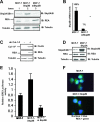Skp2B stimulates mammary gland development by inhibiting REA, the repressor of the estrogen receptor
- PMID: 17785450
- PMCID: PMC2169057
- DOI: 10.1128/MCB.01239-07
Skp2B stimulates mammary gland development by inhibiting REA, the repressor of the estrogen receptor
Abstract
Skp2B, an F-box protein of unknown function, is frequently overexpressed in breast cancer. In order to determine the function of Skp2B and whether it has a role in breast cancer, we performed a two-hybrid screen and established transgenic mice expressing Skp2B in the mammary glands. We found that Skp2B interacts with the repressor of estrogen receptor activity (REA) and that overexpression of Skp2B leads to a reduction in REA levels. In the mammary glands of MMTV-Skp2B mice, REA levels are also low. Our results show that in virgin transgenic females, Skp2B induces lobuloalveolar development and differentiation of the mammary glands normally observed during pregnancy. As this phenotype is identical to what was observed for REA heterozygote mice, our observations suggest that the Skp2B-REA interaction is physiologically relevant. However, in contrast to REA(+/-) mice, MMTV-Skp2B mice develop mammary tumors, suggesting that Skp2B affects additional proteins. These results indicate that the observed expression of Skp2B in breast cancer does contribute to tumorigenesis at least in part by modulating the activity of the estrogen receptor.
Figures







References
-
- Allar, M. A., and T. L. Wood. 2004. Expression of the insulin-like growth factor binding proteins during postnatal development of the murine mammary gland. Endocrinology 145: 2467-2477. - PubMed
-
- Boutinaud, M., J. H. Shand, M. A. Park, K. Phillips, J. Beattie, D. J. Flint, and G. J. Allan. 2004. A quantitative RT-PCR study of the mRNA expression profile of the IGF axis during mammary gland development. J. Mol. Endocrinol. 33: 195-207. - PubMed
-
- Brennan, K. R., and A. M. Brown. 2004. Wnt proteins in mammary development and cancer. J. Mammary Gland Biol. Neoplasia 9: 119-131. - PubMed
-
- Carrano, A. C., E. Eytan, A. Hershko, and M. Pagano. 1999. SKP2 is required for ubiquitin-mediated degradation of the CDK inhibitor p27. Nat. Cell Biol. 1: 193-199. - PubMed
Publication types
MeSH terms
Substances
Grants and funding
LinkOut - more resources
Full Text Sources
Molecular Biology Databases
Research Materials
